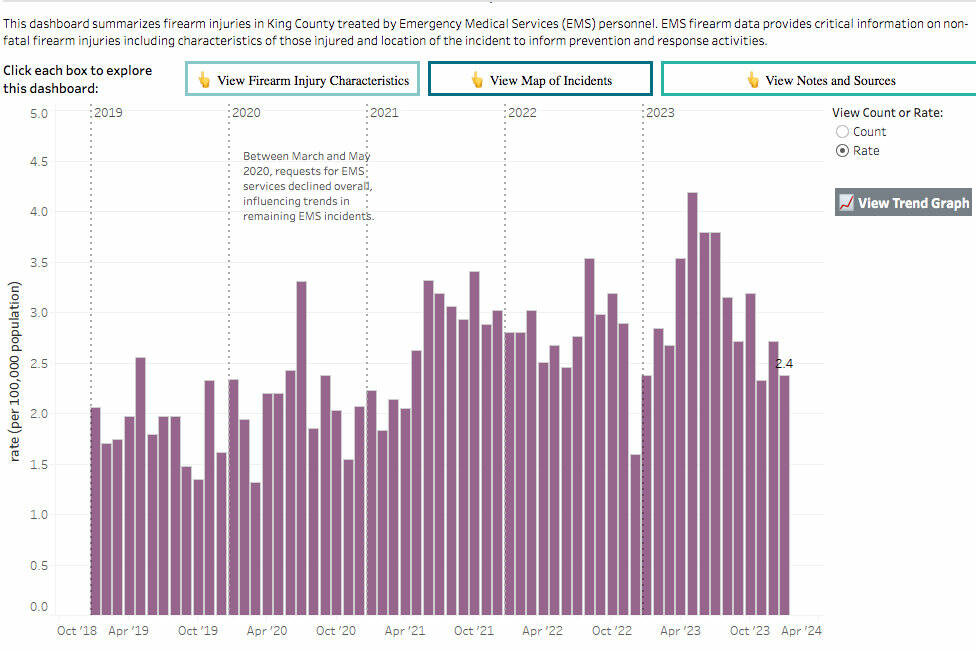The following was originally published by Kim Tippens and Aley Joseph Pallickaparambil at Public Health Insider, the official blog for Public Health — Seattle & King County. For more information, go to publichealthinsider.com.
It will probably come as no surprise to anyone living through the events of the past few years that the challenges we’ve faced have affected health. But just how are we doing in King County? Public Health—Seattle & King County did a deep dive into this question as part of the 2024/2025 King County Community Health Needs Assessment (CHNA), jointly produced by the King County Hospitals for a Healthier Community Collaborative.
As part of this work, we analyzed data by race/ethnicity to highlight disparities, opportunities, and strengths among racial/ethnic groups. This CHNA also includes a first-time look at the health impacts of climate change.
The CHNA presents community health indicators and highlights community-identified priorities. The Executive Summary and Key Findings are available online in English, and translations in Spanish and Traditional Chinese are in progress.
WHAT’S GETTING BETTER ACROSS KING COUNTY?
While more work is needed, recent data show some promising trends:
• Rates of daily vegetable consumption increased among some groups and were especially high among Black, Hispanic, lower-income, and South King County communities.
• The overall rate of attempted suicide hospitalization has declined.
• Adult cigarette smoking continues to decrease, especially among lesbian, gay, and bisexual (LGB) adults.
• Substance use among youth has declined, with a substantial 45% decline in marijuana use.
• E-cig usage among youth decreased by more than half.
• Hospitalizations from falling have declined, most notably for Native Hawaiian/Pacific Islander communities.
WHAT CAUGHT OUR ATTENTION?
We also identified opportunities for improvement coming out of the COVID-19 pandemic:
• Life expectancy is at its lowest level in nine years (81.9). For Native Hawaiians/Pacific Islanders and American Indian/Alaska Natives, life expectancy is more than ten years lower than the county average.
• Drug-induced deaths increased significantly among Black and white people and in Seattle, South King County, and North King County.
• More people are dying from unintentional injuries, including drowning, falls, fire, firearms, motor vehicle collisions, poisoning, and suffocation.
• Firearm-related incidents increased and were the highest in South King County. Black residents had the highest rate of firearm death.
• Since 2020, domestic violence emergency department visit rates increased by 48%.
• Depression among students increased county-wide, and suicide ideation among Black youth nearly doubled compared to 2020.
• Disparities in food insecurity increased, especially for Black, Hispanic, and LGBT people.
• The percentage of students meeting physical activity recommendations has declined since 2014, and the percentage of youth in the top 5% for Body Mass Index has gone up over time.
• The rate of incomplete vaccination coverage for children ages 19-35 months has increased since 2020.
• Climate change has produced deadly heat and cold events and intense wildfire seasons. Emergency Department visits for asthma and cold-related events have increased significantly in recent years. Climate change also affects food access and mental health, which community members identified as priorities.
WHAT MIGHT BE IMPACTED BY THE END OF COVID-19-RELATED ASSISTANCE?
Various types of COVID-19-related assistance ended in 2023, which will affect some more than others.
• Access to healthcare: The federal government suspended continuous enrollment for Medicaid, which will likely result in many people losing coverage over the next year. As of 2022, Hispanic and American Indian/Alaska Native adults had the highest rates of uninsurance (19.3% and 19.1%, respectively), along with those living below the federal poverty level (15%).
• Food insecurity: The federal government reinstated work requirements for certain groups to maintain eligibility for the Supplemental Nutrition Assistance Program (SNAP). This may add to existing barriers to accessing healthy food identified by communities of color (namely, rising food costs, distance from grocery stores, and lack of transportation).
WHAT HAPPENS NEXT?
The King County Hospitals for a Healthier Community (KC HHC) is a collaborative of 10 hospitals and health systems that works with Public Health—Seattle & King County to jointly produce the CHNA. Each HHC member organization then uses this information to develop its own community health improvement strategies.
The Washington State Hospital Association supports the publication of these strategies on the websites of the following HHC member organizations:
• EvergreenHealth
• Fred Hutchinson Cancer Center
• Kaiser Permanente
• MultiCare Health System
• Navos
• Overlake Medical Center & Clinics
• Providence Swedish
• Seattle Children’s
• UW Medicine
• Virginia Mason Franciscan Health
WANT TO KNOW MORE ABOUT THE CHNA REPORT AND DATA ACCESS?
The complete set of CHI indicators can be accessed at kingcounty.gov/en/legacy/depts/health/data/community-health-indicators.aspx. Additionally, stand-alone dashboards include EMS Firearm incidents, Overdose deaths, and Climate Impacts on Health on the DOH website. (Automatic translation of websites provided by Google; data remains in English).
To schedule a presentation on key findings from the 2024/2025 CHNA report or training on using Community Health Indicator dashboards to support program planning and outreach, please contact mfords@kingcounty.gov.


